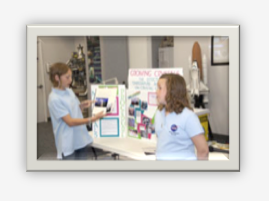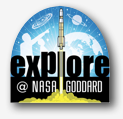 If you’re looking for ways to extend the Smart Skies: Line Up With Math module on the NASA Explorer Schools Virtual Campus, check this out. It’s one of many ideas that make the unit come alive.
If you’re looking for ways to extend the Smart Skies: Line Up With Math module on the NASA Explorer Schools Virtual Campus, check this out. It’s one of many ideas that make the unit come alive.Link to the NES Virtual Campus home page.
 If you’re looking for ways to extend the Smart Skies: Line Up With Math module on the NASA Explorer Schools Virtual Campus, check this out. It’s one of many ideas that make the unit come alive.
If you’re looking for ways to extend the Smart Skies: Line Up With Math module on the NASA Explorer Schools Virtual Campus, check this out. It’s one of many ideas that make the unit come alive.Link to the NES Virtual Campus home page.
 NASA’s Lunar Reconnaissance Orbiter team released the final set of data from the mission’s exploration phase along with the first measurements from its new life as a science satellite.
NASA’s Lunar Reconnaissance Orbiter team released the final set of data from the mission’s exploration phase along with the first measurements from its new life as a science satellite.
Link to the NES Virtual Campus home page.
 Inspiring the next generation of explorers, scientists, engineers and educators to “dream big” was the goal of this year’s NASA Explorer Schools National Student Symposium at Kennedy Space Center in Florida.
Inspiring the next generation of explorers, scientists, engineers and educators to “dream big” was the goal of this year’s NASA Explorer Schools National Student Symposium at Kennedy Space Center in Florida. Link to the NES Virtual Campus home page.
 Educators, if you are looking for additional lessons on the Electromagnetic Spectrum, check out the Satellite Meteorology module, How Light (Electromagnetic Radiation) Enables Satellites to Produce Images. The module reviews the basics of the electromagnetic spectrum and makes the connection between radiation theory and the images we get from weather satellites.
Educators, if you are looking for additional lessons on the Electromagnetic Spectrum, check out the Satellite Meteorology module, How Light (Electromagnetic Radiation) Enables Satellites to Produce Images. The module reviews the basics of the electromagnetic spectrum and makes the connection between radiation theory and the images we get from weather satellites.Link to the NES Virtual Campus home page.

Teachers – get ready for the May 4 episode of NASA Now. Mike Schoenfeld, aerospace engineer at Marshall Space Flight Center discusses his research of fission systems for space power & propulsion.
 In this episode of NASA Now, Trent Martin, project manager for the Alpha Magnetic Spectrometer experiment at Johnson Space Center in Houston, explains how NASA will try to answer one of the fundamental questions in modern physics: “What happened to the primordial antimatter?”
In this episode of NASA Now, Trent Martin, project manager for the Alpha Magnetic Spectrometer experiment at Johnson Space Center in Houston, explains how NASA will try to answer one of the fundamental questions in modern physics: “What happened to the primordial antimatter?”Link to the NES Virtual Campus home page.
NASA Now Minute: STS-134 – The Search For Antimatter

 Barrett’s NASA Save the Earth team won first prize in the Spaced Out Sports Challenge Contest! NASA contacted staff members Allyson Greene, Wendy Cohen, Laurie Sullivan, and Terry Bratt with the good news. Out of 57 entries nationwide, Barrett Elementary took first place in the contest. This accomplishment was the result of a huge team effort by all of the fifth-grade teachers, along with Renee Shaw’s wonderful filming and editing talents. The students worked very hard to design a fun, yet challenging sports-based game for astronauts on the International Space Station to play on an upcoming mission.
Barrett’s NASA Save the Earth team won first prize in the Spaced Out Sports Challenge Contest! NASA contacted staff members Allyson Greene, Wendy Cohen, Laurie Sullivan, and Terry Bratt with the good news. Out of 57 entries nationwide, Barrett Elementary took first place in the contest. This accomplishment was the result of a huge team effort by all of the fifth-grade teachers, along with Renee Shaw’s wonderful filming and editing talents. The students worked very hard to design a fun, yet challenging sports-based game for astronauts on the International Space Station to play on an upcoming mission.Link to the NES Virtual Campus home page.
 Recently, NASA Explorer Schools educator Allyson Green and the staff at K.W. Barrett Elementary School hosted their annual Science Discovery Night. The event was an open house format in their gym featuring nine science activities including telescopes, reptiles, invention convention, a videoconference with NASA, viewing student projects, LEGO Mindstorm demos, Spaced Out Sports NASA Challenge demos, and the most popular — building with LEGOS. Green and her coworkers promoted the event through their internal television system, talking with parents, sending home student-made invitations, and holding mini science fair classes for parents who do not speak English as their first language. Over 60 percent of the entire student body attended.
Recently, NASA Explorer Schools educator Allyson Green and the staff at K.W. Barrett Elementary School hosted their annual Science Discovery Night. The event was an open house format in their gym featuring nine science activities including telescopes, reptiles, invention convention, a videoconference with NASA, viewing student projects, LEGO Mindstorm demos, Spaced Out Sports NASA Challenge demos, and the most popular — building with LEGOS. Green and her coworkers promoted the event through their internal television system, talking with parents, sending home student-made invitations, and holding mini science fair classes for parents who do not speak English as their first language. Over 60 percent of the entire student body attended.Mark your calendar. On May 6th, Earth will pass through a stream of debris from Halley’s comet, producing a mild but beautiful meteor shower known as the “eta Aquarids.”
Link to the NES Virtual Campus home page.
Read the full story at http://science.nasa.gov/science-news/science-at-nasa/2011/27apr_eta/